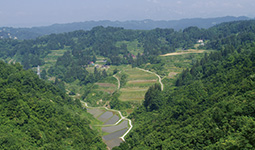Home > Highlighting JAPAN > Highlighting Japan May 2019 > Regional Revitalization
Highlighting JAPAN


A Village that Recovered Miraculously from the Verge of Extinction
A 2016 survey showed that due to the ongoing depopulation of rural areas, settlements where more than 50% of villagers are aged 65 or older and are therefore at risk of vanishing in the future account for 20.6% (around 15,000 villages) of all hamlets in Japan. Iketani Village in Tokamachi, Niigata Prefecture is one of these settlements. However, this village took a major earthquake in 2004 as an opportunity to promote interactions with people from urban areas, and by escaping from the crisis of extinction in this way achieved something more than mere recovery from the quake.
Iketani Village in Tokamachi, Niigata Prefecture is one of the snowiest areas in Japan. Approximately two hours from Tokyo by Shinkansen and conventional railway lines, the village is surrounded by beautiful terraced paddy fields on slopes in the mountains. In the 1960s, approximately 210 people in forty households lived in the settlement. However, it suffered from a continuous outflow of its population to urban areas, and when it was severely damaged in the Niigata Chuetsu Earthquake in 2004, its population decreased to just thirteen people in six households. With a growing sense of crisis, the residents of the village organized the Tokamachi Regional Development Planning Committee (currently the NPO Chiikiokoshi [lit. Community Development]) and began to accept volunteers who would help them with snow shoveling, farm work, and other tasks as well as post-earthquake reconstruction work. Tomoyoshi Tada, who now serves as the director-general of NPO Chiikiokoshi, participated in the reconstruction support in 2009 as a volunteer from Tokyo.
“Iketani Village is a depopulated community that is located deep in the mountains. Accordingly, before I came here, I somehow had the impression that it was a closed community. When I actually came here, however, I found that it was the complete opposite to my impression. I was surprised by the welcoming atmosphere, and the people in the village were cheerful and talked to me in a friendly manner.”
Success in keeping Iketani Village alive after it was on the verge of extinction will definitely provide a clue as to how to revitalize all the farming and mountain villages in Japan that face similar issues, such as a shortage of farming successors and the degradation of forest lands. Moved by the big vision, positive attitude and enthusiasm of the local people, in February 2010 Tada applied for the Local Vitalization Cooperator, a program of the Ministry of Internal Affairs and Communications that had been launched in the same year. Under this program, municipal governments solicit urban residents who are interested in life in a rural area and intend to live in an underpopulated area to participate in activities for developing the local communities, engage in farming, forestry, or fishery, or provide livelihood support to local residents. It is aimed at having participants live in the communities permanently or otherwise continue to engage with the villages after undertaking the above activities for one to three years. In fiscal 2018, 5,530 people are engaging in the activities. Tada immigrated from Tokyo to Iketani Village with his wife and son, who was two years old at the time. After completing his three-year term, he decided to stay in the village and continue to work as a member of NPO Chiikiokoshi.
In addition to operating the main business of producing rice by using spring water and selling it, NPO Chiikiokoshi organizes tours for the collection of mountain vegetables and rice planting events, and accepts interns who wish to experience life in the village. During the six years from 2013, it accepted fifty-six interns, ranging from teenagers to those in their 60s. Of them, eighteen people in fifteen households have settled down in Tokamachi. Tada believes that what led them to live there permanently was their friendly relationships with the local residents, which they developed through a wide range of activities including farming work and assistance in event organization. The population of Iketani Village has now increased to twenty-one people in nine households, including six children aged from one to eleven years. While the number of residents is by no means large, the village is about to recover from the verge of extinction.
“Rural areas have a lot of potential, including their beautiful nature and food. What I consider to be most important among them is the people. People in the communities, not the local governments, should take the initiative in drawing attention to local treasures and engaging with people from urban areas. I think that this will lead to local revitalization,” said Tada.
The goal of NPO Chiikiokoshi is for the village to exist for 100 years. The basis of its livelihood will be stronger if the local procurement of clothing, food, housing, and energy such as electricity, water and gas becomes possible in the future. People including Tada will continue to take on challenges to develop a village where people can continue to live with a sense of security until the next generation.
© 2009 Cabinet Office, Government of Japan








